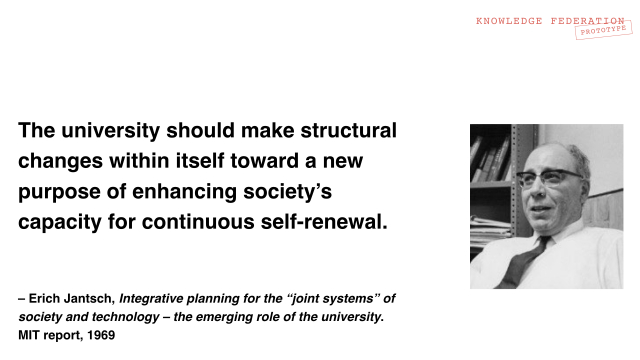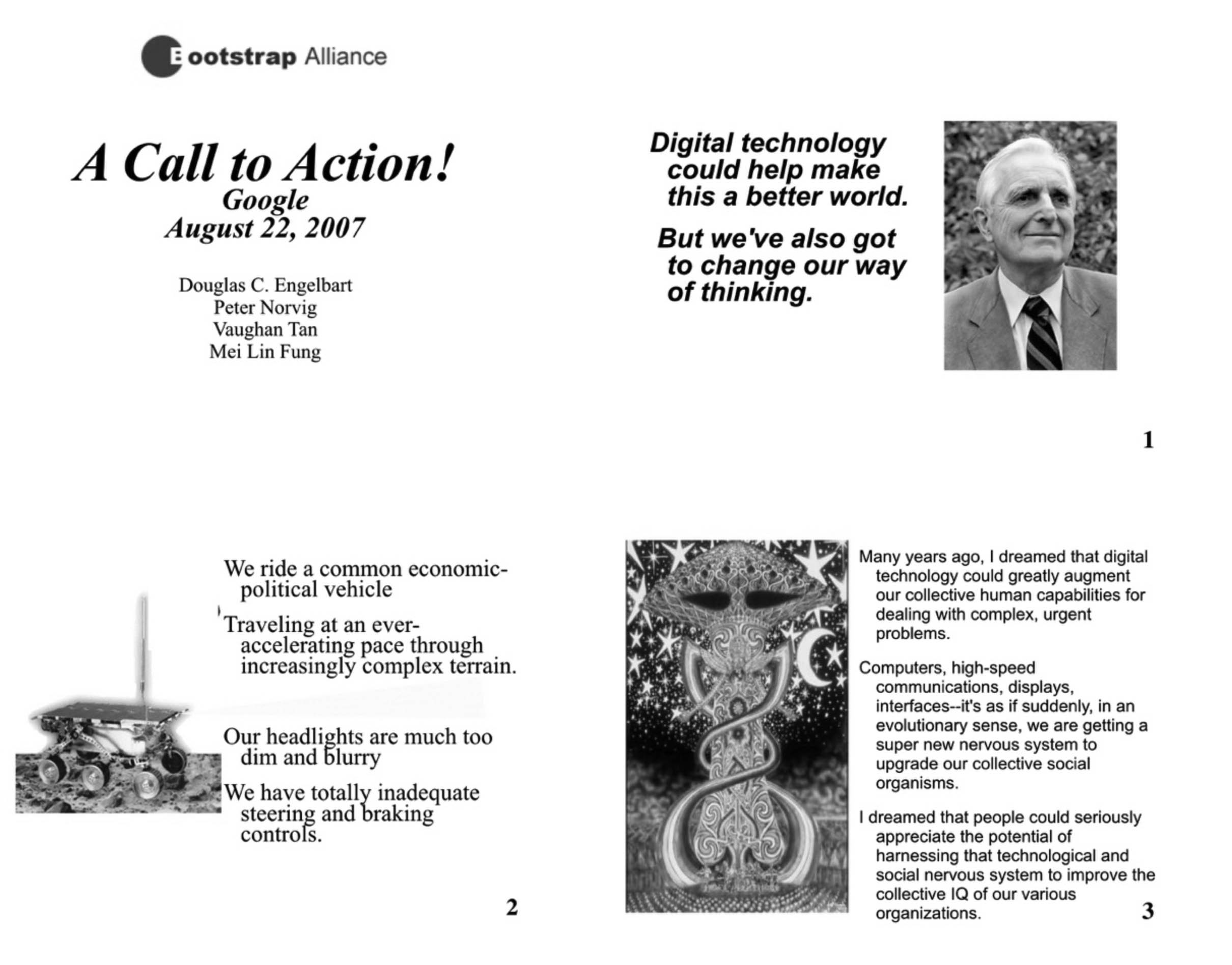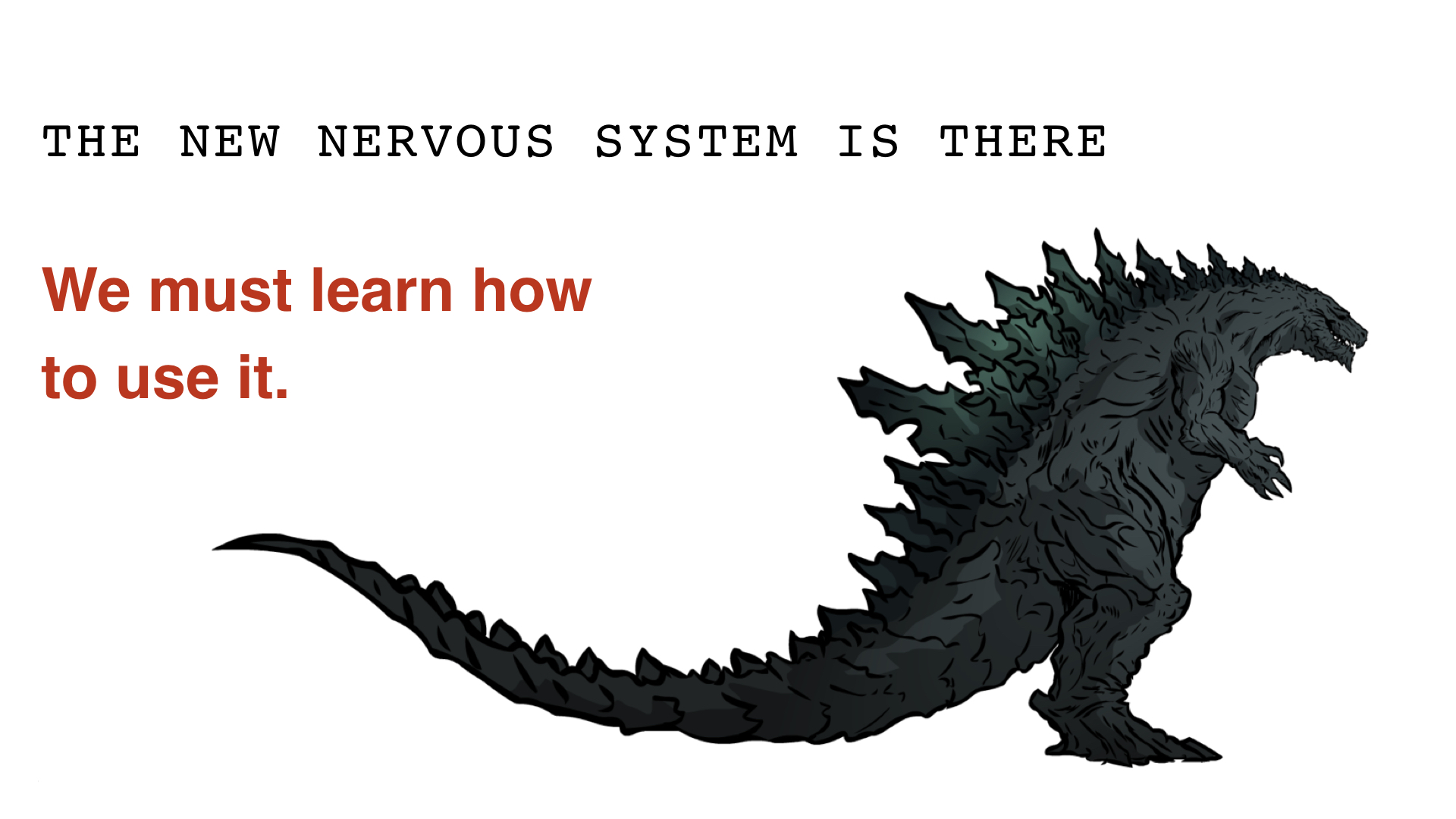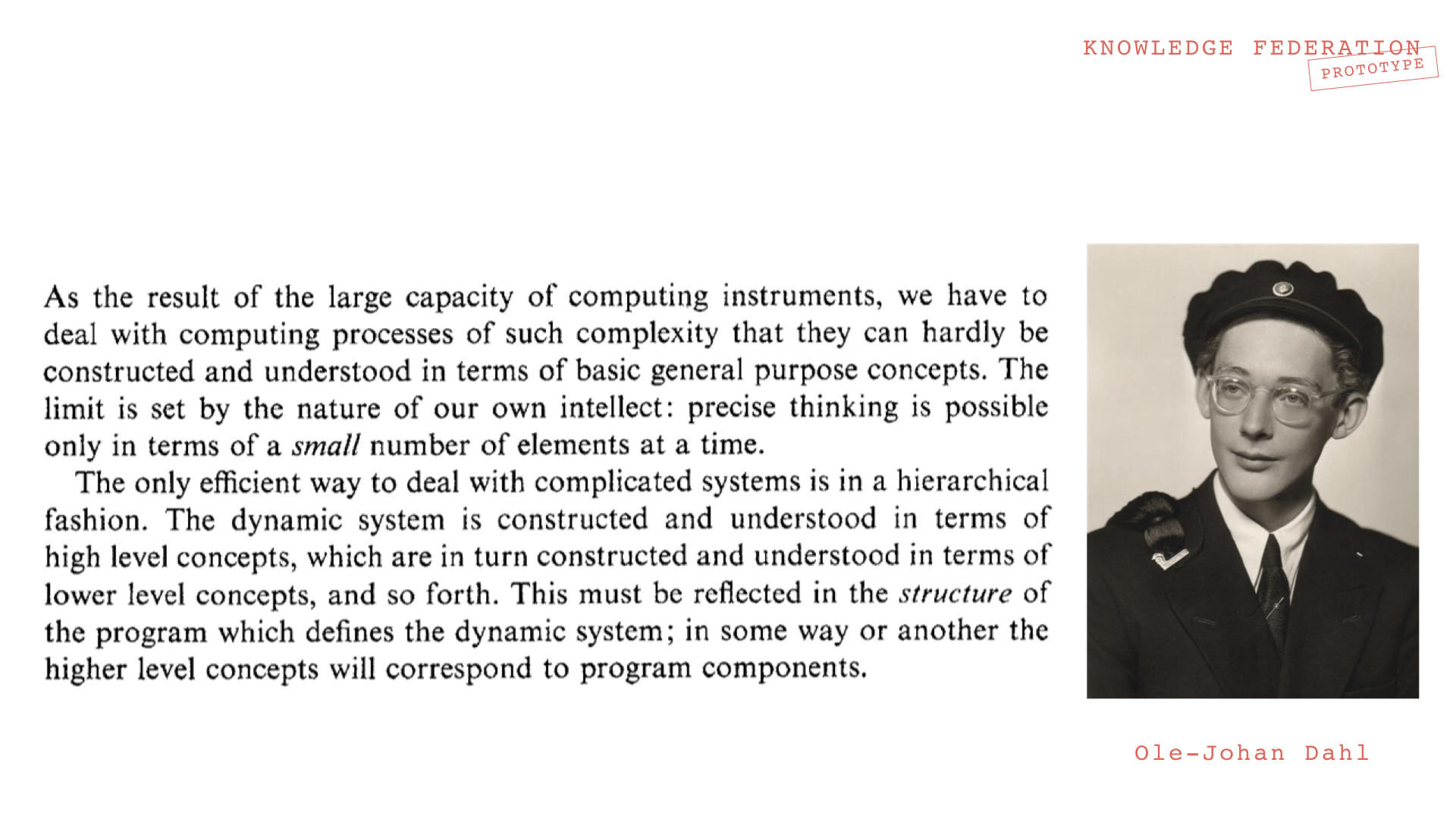Holotopia: Collective mind
Contents
- 1 H O L O T O P I A: F I V E I N S I G H T S
- 2 Collective mind
- 2.1 Stories
- 2.2 Our collective mind needs a structural change
- 2.3 The change must begin with 'headlights'
- 2.4 Enter new information technology
- 2.5 Ideogram
- 2.6 Keywords
- 2.7 Knowledge federation
- 2.8 Information holon
- 2.9 Ideogram
- 2.10 Bootstrapping
- 2.11 Prototypes
- 2.12 The Lighthouse
- 2.13 TNC2015
- 2.14 BCN2011
H O L O T O P I A: F I V E I N S I G H T S
Collective mind
The printing press revolutionized communication, and enabled the Enlightenment. We are now witnessing a similar revolution—spearheaded by the Internet and the new media. Are we comparing that with candle headlights?
We look at the way in which this new technology is being used. And at the principle of operation that underlies this use. Without noticing, we have adopted the principle of operation that suited the old technology, the printing press—broadcasting. But the new technology, by linking us together in a similar way as the nervous system links the cells in an organism, enables and even demands completely new modalities of collaboration. Imagine if your own cells were using your nervous system to merely broadcast data! In a collective mind, broadcasting leads to collective madness—and not to "collective intelligence" as the creators of the new technology intended.
Stories
Our collective mind needs a structural change
Knowledge work has a flat tire
We used the brief thread under this title, consisting of two vignettes and a punchline, as a springboard story for launching our Silicon Valley presentation of Knowledge Federation in 2011. We offer it here for the same purpose. An academic and media situation related to the climate crisis, where two esteemed scientists contradict one another on an all-important issue, is described to point to another all-important but less known issue. Our point was that, metaphorically speaking, pressing the gas pedal and rushing forward (writing up, publishing and broadcasting our ideas and opinions) was out of tune with the nature of our situation. Our situation demands that we stop and take care of a structural issue. The stories are shared here.
The largest contribution to knowledge
When a decade ago, when we were "evangelizing" for our reorganization of Knowledge Federation as a transdiscipline, we told the story how Bourdieu teamed up with Coleman, and undertook to put sociology back together. And how Bourdieu made a case for this attempted structural change of sociology, by arguing why it may be "the largest contribution" to the field. It remained to point to the obvious—that Bourdieu's observation is far more true when we look at sociology as a piece in a larger puzzle, of our society. A description with links is provided here.
Yet an even larger contribution to knowledge is possible than structural updates to existing disciplines. It can be achieved by adding to our academic repertoire of capabilities the capability to make structural updates to knowledge-work and other institutions.
It is this capability that the knowledge federation transdiscipline aims to provide.
The change must begin with 'headlights'
The communication is the system
Let us for a moment revisit Norbert Wiener's and Erich Jantsch's insights, that to be able to solve its problems, our society needs a new capability—the capability to update its core institutions and other systems. Or in holotopia's parlance, the capability "to make things whole".
That the natural place to begin developing this capability is our 'collective mind', or 'headlights', follows from that very history! (At the Visions of Possible Worlds conference, at the Triennale di Milano in 2003, we presented a different argument for the same conclusion, wee it here.)
Wiener began the last chapter of his 1948 Cybernetics (a copy of which we provided here), titled "Information, Language and Society", by observing that the communication largely determines the structure of a system; in social systems, the communication is the system (being what enables a collection of disparate entities to function together as an entity).
We need "evolutionary guidance"
We have introduced Erich Jantsch as a link between the universe of the systems sciences, and the universe where The Club of Rome belongs, where the goal is to secure our civilization's future. Erich Jantsch's final message, however, may be summarized by the formula that intervening into (or "designing for") the evolution is the key to our contemporary situation (see our summary here. But that is, of course, what the Modernity ideogram is also saying.
"The invisible hand" won the argument
Coincidentally, Erich Jantsch passed away in the same year when Ronald Reagan became the US president—on an agenda opposite to his and wiener's.
Reagan did not win by the force of the argument, but by having incomparably more "air time" than our two academic heroes.
We may now see who 'keeps Galilei in house arrest', and how. Well before the advent of the Internet, Umberto Eco was comparing the New York Times and (then the main Soviet communist paper) Pravda, and arguing that while in the latter censorship was achieved directly, in the former the same effect was produced by the sheer overabundance of information.
</p> </div> </div>
Enter new information technology
Wiener developed his argument in the last chapter of Cybernetics partly by quoting Vannevar Bush—at the time the academic strategist par excellence, who already in 1945 pointed to the issue at hand as the one that the scientists must give the highest priority, (see our summary here).
Doug Engelbart's vision
In 1968, Doug Engelbart and his SRI team provided demonstrated a prototype answer to Bush's call to action, which was well beyond what Bush was able to envision. The congruence between Engelbart's vision and Wiener's and Jantsch's is striking. We highlight it by showing the above four Engelbart's slides, which were intended to present his vision to the world at its 2007 presentation at Google. Engelbart even used the same metaphor as we did, to make his point! The longer story will be presented in the book tentatively titled "Systemic Innovation", and subtitled "The future of democracy". A short outline of Engelbart's story and vision is provided here. We also offer two 15-minute videotaped lectures presenting an introduction to Engelbart's vision, and explaining its essence.
Ideogram
Our civilization is like an organism that has recently grown beyond bounds ("exponentially")—and now represents a threat to its environment, and to itself. By a most fortunate mutation, this creature has recently developed a nervous system, which could allow it to comprehend the world and coordinate its actions. But the creature is using it only to amplify its most primitive, limbic impulses.
Keywords
Knowledge federation
We use this keyword, knowledge federation, in a similar way as "design" and "architecture" are commonly used—to signify both a set of activities, and an academic field that develops them.
As a set of activities, knowledge federation can now be understood as the workings of a well-functioning collective mind. Instead of broadcasting, the cells and organs (researchers, disciplines, communities...) process the information they are handling and dispatch suitably prepared pieces to suitable other cells and organs. The prefrontal lobe receives what it needs. And so do the muscles. In the development of a collective mind that federates knowledge, the cells self-organize, specialize, develop completely new goals, processes, ways of working...
How does it all work? 'Programming' our collective mind is what knowledge federation as transdiscipline is all about. It draws insights from all relevant fields—and weaves them into the very functioning of our collective mind. Yes, this is roughly what philosophy was or appeared to be all about, in the old paradigm.
As an academic field, knowledge federation develops the praxis of knowledge federation. There is phenomenally much to be done—since everything that the tradition has given us and we customarily take for granted (all those 'candles'...) now need to be reassessed and reconfigured.
In the analogy with computer programming, knowledge federation roughly corresponds to object orientation. Here is how Old-Johan Dahl, one of the creators of the Object Oriented Methodology, described the underlying idea.
Information holon
It is offered as a counterpart to "object" in object oriented methodology (as we summarized here).
The Information idogram, shown on the right, explains its principle of operation.
The ideogram shows an "i", which stands for "information", as composed of a circle placed on top of a square. The square stands for the details; and also for looking at a theme of choice from all sides, by using diverse kinds of sources and resources. The circle, or the dot on the "i", stands for the function or the point of it all. That might be an insight into the nature of a situation; or a rule of thumb, pointing to a general way to handle situations of a specific kind; or a project, which implements such handling.
By showing the circle as founded on the square, the Information ideogram points to knowledge federation as a social process (the 'principle of operation' of the socio-technical 'lightbulb'), by which the insights, principles, strategic handling and whatever else may help us understand and take care of our increasingly complex world are kept consistent with each other, and with the information we own.
Ideogram
The ideograms as they presently are in the holoscope serve as a laceholder—for a variety of techniques that can be developed by using contemporary media technology. The point here is to condense lots and lots of insights into something that communicates them most effectively—which can be a poem, a picture, a video, a movie....
An ideogram the naturally serves for composing the circle–which condenses a wealth of insights into a simple, communicated message.
Instead of using media tools addictively, and commercially, we use them to rebuild the culture—as people have done through ages. The difference is made by the knowledge federation infrastructure—which secures that what needs to be federated gets federated.
Bootstrapping
We adopted this keyword, bootstrapping, from Doug Engelbart, who used it to point to the key next step we need to take in the evolution of knowledge work (now that the technology is in place). His pint was close to Jantsch's—we must self-organize, and help self-organization scale!
Knowledge Federation was conceived by an act of bootstrapping—to foster the larger bootstrapping capability, in academia and beyond.
Bootstrapping points to a proactive and co-creative stance, which now needs to replace both "minding our business" in business, and the "objective observer" stance of an academic.
The example prototypes shown below are at the same time instances of bootstrapping
Prototypes
The Lighthouse
Dissolves the Wiener's paradox. A template for a way for academia to break the "objective observer" spell. Embedded exactly at the core point—to challenge the "the invisible hand" doctrine... See it described here.
TNC2015
Tesla and the Nature of Creativity (TNC2015) is a complete example of knowledge federation in academic communication, which shows how an academic result is federated. See it described in the Tesla and the Nature of Creativity and A Collective Mind – Part One blog posts.
BCN2011
The Barcelona Innovation Ecosystem for Good Journalism (BCN2011) is a complete prototype showing how public informing can be reconstructed, to federate the most relevant information, according to the needs of people and society. A description with links is provided here.





